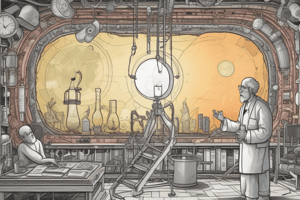Podcast
Questions and Answers
What is a key advantage of using the experimental method in research?
What is a key advantage of using the experimental method in research?
- It relies on subjective observations.
- It minimizes personal biases. (correct)
- It focuses only on qualitative measures.
- It eliminates the need for replication.
Experiments can be conducted in real-world settings without any constraints.
Experiments can be conducted in real-world settings without any constraints.
False (B)
Name one historical experiment that has been replicated to confirm findings on authority and obedience.
Name one historical experiment that has been replicated to confirm findings on authority and obedience.
Milgram’s obedience experiments
In studies examining the effects of exercise, precise instruments like __________ provide measurable results.
In studies examining the effects of exercise, precise instruments like __________ provide measurable results.
Match the following experiments with their contributions to scientific theories:
Match the following experiments with their contributions to scientific theories:
What is one way that advance planning can enhance research?
What is one way that advance planning can enhance research?
Using informal experimental designs typically involves rigorous control and randomization.
Using informal experimental designs typically involves rigorous control and randomization.
What is the independent variable in an experiment studying the effects of sleep on memory retention?
What is the independent variable in an experiment studying the effects of sleep on memory retention?
In the before and after without control design, participants are observed __________ an intervention.
In the before and after without control design, participants are observed __________ an intervention.
Match the following research designs to their descriptions:
Match the following research designs to their descriptions:
What is a key advantage of the experimental method regarding causation?
What is a key advantage of the experimental method regarding causation?
The experimental method does not allow for controlling extraneous variables.
The experimental method does not allow for controlling extraneous variables.
What ensures the replicability of an experiment?
What ensures the replicability of an experiment?
In a caffeine experiment, the _____ group is given a placebo.
In a caffeine experiment, the _____ group is given a placebo.
Match the following experimental examples to their advantages:
Match the following experimental examples to their advantages:
Flashcards
Cause and effect
Cause and effect
The experimental method allows researchers to determine if one variable directly influences another. This is done by manipulating the independent variable and observing its effect on the dependent variable while controlling other factors.
Control over Variables
Control over Variables
Experiments allow researchers to isolate and control variables, minimizing the influence of extraneous factors on the results.
Replicability
Replicability
The experimental method's clear procedures and controls allow other researchers to replicate the study and verify the findings, increasing confidence in the results.
Precise Results
Precise Results
Signup and view all the flashcards
Reliable Results
Reliable Results
Signup and view all the flashcards
Replicability in Experiments
Replicability in Experiments
Signup and view all the flashcards
Objectivity in Experiments
Objectivity in Experiments
Signup and view all the flashcards
Artificiality in Experiments
Artificiality in Experiments
Signup and view all the flashcards
Theoretical Advancement through Experiments
Theoretical Advancement through Experiments
Signup and view all the flashcards
Cause and Effect in Experiments
Cause and Effect in Experiments
Signup and view all the flashcards
Before-and-After Without Control Design
Before-and-After Without Control Design
Signup and view all the flashcards
Before-and-After With Control Design
Before-and-After With Control Design
Signup and view all the flashcards
Multiple-Group Before-and-After Design
Multiple-Group Before-and-After Design
Signup and view all the flashcards
Cross-Sectional Design
Cross-Sectional Design
Signup and view all the flashcards
Longitudinal Design
Longitudinal Design
Signup and view all the flashcards
Study Notes
The Experimental Method
- The experimental method is a significant tool in science for understanding cause-and-effect relationships. It involves manipulating variables under controlled conditions.
- An experiment is an investigation where a hypothesis is tested. The independent variable is manipulated by the researcher, and the dependent variable is measured to observe its response.
- Extraneous variables are controlled to prevent them from influencing the outcome.
Key Features of the Experimental Method
- Control Over Variables: External factors (extraneous variables) are controlled to not interfere with results. For example, in a new teaching method experiment, prior knowledge, age, and classroom environment are kept consistent for participants.
- Careful Measurement: Accurate and precise measurement of outcomes is important for valid results. Using a stopwatch to time a reaction-time task is an example.
- Establishing Cause-and-Effect Relationships: Researchers infer causal links by manipulating the independent variable and observing its effect on the dependent variable. An example is testing if sunlight exposure affects plant growth.
- Use of Experimental and Control Groups: The experimental group receives the independent variable treatment, and the control group does not. This comparison helps determine the effect of the variable.
Variables in Experiments
- A variable is any concept or factor that can take on different values. These can be quantitative (numbers) or qualitative (categories).
- Independent Variable (IV): The variable manipulated by the experimenter. It is assumed to impact the dependent variable. e.g., drug dose.
- Dependent Variable (DV): The variable that is measured by the experimenter. It is the outcome or effect of the experiment. e.g., memory performance.
- Extraneous Variable: A variable that isn't the focus of the study but could affect the dependent variable. e.g., sleep levels.
- Confounded Relationship: This occurs when the dependent variable is influenced by an extraneous variable, making it unclear if the independent variable is the true cause of the change. e.g., different study environments for students using flashcards or reading notes.
Types of Variables
- Continuous Variable: A variable that can take any value within a given range, including decimals. e.g., height.
- Discrete Variable: A variable that can only take on specific, whole values, not fractions. e.g., number of children in a family.
Control in Research
- Control is necessary in research to manage the influence of extraneous variables on the dependent variable.
- This ensures the independent variable is the only factor affecting the result.
- Methods to achieve control include: randomization, matching participants based on similar characteristics, and standardization of conditions (e.g., lighting, temperature).
Hypothesis
- A hypothesis is a predictive statement that proposes a relationship between variables.
- It is a testable statement about the relationship between the independent and dependent variables. e.g., Drug A improves memory performance.
Experimental Design
- Experimental design is a structured plan for conducting research.
- It ensures the methodology, data collection and analysis align with the research goals, while controlling for extraneous variables.
- It helps to establish cause and effect relationships while ensuring research is consistent and reliable.
Types of Experiments
- Laboratory Controlled Experiments: Conducted in a controlled environment where researchers have full control over variables. Example: Testing the effect of caffeine on memory in a lab setting.
- Field Experiments: Conducted in natural settings with less control over extraneous variables. Example: Testing the effect of a new teaching method in different classrooms.
- Natural Experiments: Observing naturally occurring events to examine their impact, without manipulating or changing any factors. Example: Studying the effects of a natural disaster on mental health.
Ethical Considerations in Research
- Confidentiality: Protecting participant's privacy.
- Voluntary Participation: Participants must freely consent and have the right to withdraw at any time.
- Informed Consent: Participants must be informed about the study's purpose, procedures, potential risks, and benefits.
- Debriefing: Researchers explain the study afterward, including any deception used.
- Protection of Participants: Ensuring psychological and physical well-being during the study.
Studying That Suits You
Use AI to generate personalized quizzes and flashcards to suit your learning preferences.




